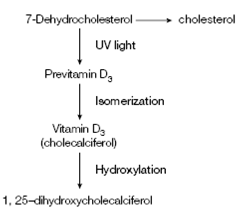Vitamin D:
Vitamin D is derived from 7-dehydrocholesterol through the action of the UV component of sunlight on the skin. The UV light brings about photolysis of 7- dehydrocholesterol among C-9 and -10 with leading to a rearrangement of the double bonds of the molecule to form previtamin D3 shown in the figure. This molecule spontaneously isomerizes to form vitamin D3 (cholecalciferol). Following hydroxylation reactions take place in the liver and kidneys to produce 1, 25- dihydroxycholecalcerol (1, 25(OH) D3), the active hormone. Rickets that is caused through a deficiency of vitamin D was historically a common disease of childhood in Britain due to the low vitamin D content of the national diet and lack of exposure to sunlight. Still presents, people whose cultures need the body to be clothed so in which no skin is exposed to sunlight have problems in

Figure: Formation of vitamin D.

maintaining an adequate vitamin D level. In the adults this takes the creation of osteomalacia - the softening or weakening of the bones.